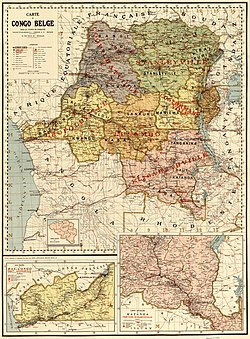Kóngò Bẹ́ljíọ̀m
Appearance
| Àyọkà yìí únfẹ́ ìyílédèdà sí Yorùbá. Ẹ ran Wikipedia lọ́wọ́ ṣàtúnṣe sí ìyílédèdà |
| |||||||||||||||||||||||||||||||||||||||||||||||||||||||||||||||||||
The Belgian Congo (French: Congo Belge; Dutch: ![]() Belgisch-Kongo (ìrànwọ́·ìkéde)) was the formal title of present-day Democratic Republic of the Congo (DRC) between King Leopold II’s formal relinquishment of his personal control over the state to Belgium on 15 November 1908, and Congolese independence on 30 June 1960.[3]
Belgisch-Kongo (ìrànwọ́·ìkéde)) was the formal title of present-day Democratic Republic of the Congo (DRC) between King Leopold II’s formal relinquishment of his personal control over the state to Belgium on 15 November 1908, and Congolese independence on 30 June 1960.[3]

|
Àyọkà yìí tàbí apá rẹ̀ únfẹ́ àtúnṣe sí. Ẹ le fẹ̀ jù báyìí lọ tàbí kí ẹ ṣàtúnṣe rẹ̀ lọ́nà tí yíò mu kúnrẹ́rẹ́. Ẹ ran Wikipedia lọ́wọ́ láti fẹ̀ẹ́ jù báyìí lọ. |
Itokasi
[àtúnṣe | àtúnṣe àmìọ̀rọ̀]- ↑ (Faransé) République démocratique du Congo Archived 2012-11-27 at the Wayback Machine., Laval University, Canada
- ↑ (Duki) Vlamingen en Afrikanen—Vlamingen in Centraal Afrika, Faculteit Sociale Wetenschappen, Katholieke Universiteit Leuven, Belgium
- ↑ Georges Nzongola-Ntalaja (2002). The Congo from Leopold to Kabila: A People's History. Zed Books. ISBN 1-84277-053-5.



